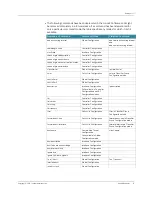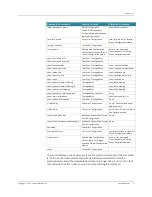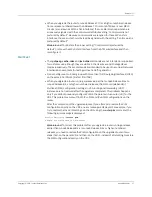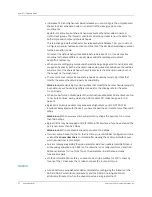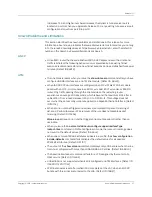
JunosE 11.1.1 Release Notes
28
Known Behavior
Copyright © 2010, Juniper Networks, Inc.
To restore IPv4 PIM configuration on the VRF, perform the following steps. These
steps assume that a parent VR context, named “parent”, and a VRF in the parent VR,
named “vrf01”, are already configured on the router.
1.
Access the context of the parent VR, and create and enable IPv4 PIM on the
parent VR.
host1(config)#
virtual-router parent
host1:parent(config)#
router pim
2.
Enter the VRF Configuration mode to restore PIM settings on the VRF in the
parent VR.
host1:parent(config)
#
virtual-router parent:vrf01
3.
Create and enable IPv4 PIM on the VRF in the parent VR.
host1:parent:vrf01(config)#
router pim
After the IPv4 PIM configuration is recovered on the VRF, you can remove the IPv4
PIM configuration settings on the parent VR by using the
no router pim
command, if
necessary.
To restore IPv6 PIM configuration on the VRF, perform the following steps. These
steps assume that a parent VR context, named “parent”, and a VRF in the parent VR,
named “vrf01”, are already configured on the router.
1.
Access the context of the parent VR, and create and enable IPv6 PIM on the
parent VR.
host1(config)
#
virtual-router parent
host1:parent(config)
#
ipv6 router pim
2.
Enter the VRF Configuration mode to restore PIM settings on the VRF in the
parent VR.
host1:parent(config)#
virtual-router parent:vrf01
3.
Create and enable IPv6 PIM on the VRF in the parent VR.
host1:parent:vrf01(config)#
ipv6 router pim
After the IPv6 PIM configuration is recovered on the VRF, you can remove the IPv6
PIM configuration settings on the parent VR by using the
no ipv6 router pim
command, if necessary.
Packet Mirroring
z
The ES2 10G LM supports the packet mirroring feature when the module is paired
with the ES2-S2 10GE PR IOA, the ES2-S1 GE-8 IOA, or the ES2-S3 GE-20 IOA. When
you use the ES2 10G LM with these IOAs, CLI-based interface-specific mirroring is not
supported.
z
When both interface-specific mirroring and user-specific mirroring are configured on
the same interface, the interface-specific secure policies take precedence. The
interface-specific secure policies, which you manually attach using the CLI, override
and remove any existing secure polices that were attached by a trigger action. If the
interface-specific secure polices are subsequently deleted, the original trigger-based
secure policies are not restored.


